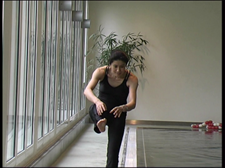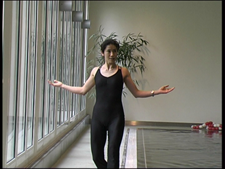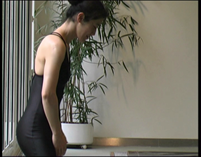CLINICAL AI CHI (CAC) and Postural Control During Balance and Gait
- Andrea Salzman

- Sep 10
- 4 min read
Updated: 4 days ago
Byeline: Johan Lambeck, www.halliwick.eu
Clinical Ai Chi (CAC) is the therapeutic application of regular Ai Chi, which has proven to have beneficial effects on, e.g., postural control and a decreased risk of falling. Regular Ai Chi has proven to be effective for persons with various diseases, like, e.g., multiple sclerosis, Parkinson’s, stroke, or fibromyalgia. In 2021, Dunlap, Lambeck, Ku, and Gobert published a scoping review in the Journal of Aquatic Physical Therapy. Moderate to large clinically relevant effect sizes were found for postural control outcome measures—like the Berg Balance Scale and Timed Up and Go—in comparison with control interventions on land (inter-group)

as well as for intra-group changes over time. Included client groups were chronic stroke, multiple sclerosis, Parkinson's, and elderly with balance problems. Examples are publications by Kurt et al. (2017), Ku et al. (2020), and Pérez-de la Cruz (2021)
Ai Chi and Tai Chi
Ai Chi is often compared with simple Tai Chi, which is strongly recommended, when feasible, in the World guidelines for falls prevention and management for older adults: a global initiative (2022): a multidomain intervention for all older adults regardless of their assessed risk of falling or age. Exercises should be challenging, individualized, and progressive. The recommendation is based on 2 systematic reviews. The second one (Sherrington 2021) was based on 9 controlled studies and concludes that Tai Chi probably reduces falling with a fall reduction of 23%. The scoping review by Dunlap et al. was based on 11 controlled studies in the same Pedro range as the Tai Chi studies. I calculated a fall reduction of 21% for the Ai Chi studies. Ai Chi and Tai Chi seem to be equally effective, and patient preference might be a decisive factor, apart from the availability of a pool.

A pool adds extra advantages. When persons are safe (and feel safe), they are prepared to make larger and more challenging movements than on land without the risk of losing that balance. McCrum (2020) addressed the hampering issue about safety and apprehension in land-based perturbation training.
Controlling reaching at the end of a large range of movement is essential for safe activities of daily living. To feel safe during Ai Chi, a client should dare to lose balance and know how to stand up. This can be achieved by some preparation using Halliwick.
Postural control
Ai Chi is simple but effective on measurement instruments for the capacity of proactive/predictive postural control. The 20 kata form a sequence with gradually increasing difficulty. Progressive parameters start from:
• only arm movements to whole body movements
• symmetrical to asymmetrical arm movements
• a static to a moving center of gravity
• a wide to a narrow basis of support
• foot-in-place to walking (sideways)
• a fixed visual point for eyes following the moving hand
• a small body displacement to large ones
Dosage of these parameters, as well as number of repetitions, varies among publications, but that has had no effects on the effectiveness of Ai Chi. Various protocols have been gathered at www.clinicalaichi.org. Ai Chi usually is offered in group, whether this one-size-fits-all principle has decreased the clinical effect sizes has not been explored in literature.
Clinical Ai Chi
When Ai Chi is included in a physical therapy program—Clinical Ai Chi (CAC)—parameters should fit in a personalized intervention and be the result of a clinical reasoning process, fitting in, e.g., the categories “Neuromusculoskeletal – and movement-related functions (b7)” and “Mobility (d4)” of the ICF (International Classification of Functioning, Disability and Health). Clinical questions then could be “Can CAC be adapted to facilitate hip strategies in persons with persistent low back pain?” or “Can CAC be adapted to persons with Parkinson’s in order to train medio-lateral stability?
Persons with persistent low back pain may protect their back with increased muscular contraction activity (with fascial adaptation mechanisms), resulting in a decreased involvement of the lumbopelvic area to control the center of gravity. This is often compensated by ankle strategies, compensatory stepping, or use of arms and hands.
During equilibrium—or supporting reactions. To try to integrate hip strategies in the normal reactive postural repertoire, Ai Chi katas can be modified: rounding can be an example of addressing an anterior-posterior hip strategy in part.
When transferring weight backward, the extension (opening) should be changed from a mid-thoracic focus to focus on the lumbo-sacral segments with forward pelvic tilt and hip extension, and when weight-shifting forward, the pelvis should be tilted backward accompanied by hip flexion.
Rounding
Persons with Parkinson (Y&H 2 and 3) show balance impairments in posture and gait, like, e.g., a decreased medio-lateral stability with increased risk of falling, especially when walking slowly with a narrow gait pattern. Medio-lateral stability is about maintaining symmetry, transferring weight, and compensatory sideways stepping with a sidestep
strategy. It is known that a crossover strategy might make persons fall and is not advised. This means that flowing (crossover) should be changed: just open and close legs during side stepping.
Also, e.g., in the first series of katas, like flowing or contemplating, a client could be asked not to stand symmetrically but to transfer weight to one leg and stay there without compensation, like a Trendelenburg or Duchenne, during the katas.
References
Ku P-H, Chen S-F, Yang Y-R, Lai T-C, Wang R-Y. The effects of Ai Chi for balance in individuals with chronic stroke: a randomized controlled trial. Scientific Reports, 2020;10:201. https://doi.org/10.1038/s41598-020-58098-0
Kurt EA, Büyükturan B, Büyükturan Ö, Erdem HR. Effects of Ai Chi on balance, quality of life, functional mobility and motor impairment in patients with Parkinson’s disease. Disability and Rehabilitation, 2017. doi:10.1080/09638288.2016.1276972
Pérez-de la Cruz S. Comparison between Three Therapeutic Options for the Treatment of Balance and Gait in Stroke: A Randomized Controlled Trial. Int. J. Environ. Res. Public Health 2021. https://doi.org/10.3390/ijerph18020426
Dunlap E, Lambeck J, Ku P-H, Gobert D. Ai Chi for balance, pain, functional mobility and quality of life in adults: a scoping review. J Aquat Phys Ther 2021;29:14-28. doi: 10.1097/JAPT-D-20-00014
World guidelines for falls prevention and management for older adults: a global initiative. Montero-Odasso M, Velde vd N,Martin FC, et al. Age and Ageing 2022; 51: 1–36 https://doi.org/10.1093/ageing/afac205
McCrum C, Bhatt TS, Gerards MHG, Karamanidis K, Rogers MW, Lord SR, Okubo . Perturbation-based balance training: Principles, mechanisms and implementation in clinical practice. Front. Sports Act. Living 2022. doi:10.3389/fspor.2022.1015394
Want to dip your toes into aquatics? Check out this introductory course:








